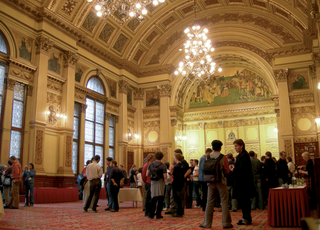
By Peter Kreußel
The first two days of the KDE developer conference [1], aKademy 2007, focused on KDE 4. Many central components for the new major release, which is expected in the fall, have been rewritten from scratch. Thanks to KDE's Plasma Framework [2], which aims to integrate elements of the SuperKaramba widget manager with the standard KDE desktop, the KDE 4 desktop will have access to familiar SuperKaramba components.
KDE is also introducing various multimedia enhancements: the Arts sound server, which has often been criticized as unreliable and hard to integrate with application development, is now a thing of the past. Its successor is the new Phonon [3] audio/video framework, which leaves audio playback to various back-ends, such as Xine or the Helix engine, and the Gstreamer framework. In addition to its ability to mix multiple audio tracks, Phonon also makes it easier to develop video playback applications.
Desktop search engines are another technology that attracted audience attention: As a replacement for Kat, which is no longer maintained, KDE 4 will be introducing Strigi [4]. The new search engine relies on the Nepomuk semantic subsystem, which stores meta information such as exif tags or author data in a standardized database. The new Dolphin file manager will also benefit from the semantic subsystem and will support comments and file ranking.
KDE 4 is aiming to facilitate the development of software optimized for multiple CPU systems. The ThreadWeaver [5] component makes this possible by giving developers the ability to distribute program execution over multiple parallel threads. A process scheduler ensures that threads are executed in the right order.
Besides KDE developers, various guest speakers gave talks. The first guest speaker was Lars Knoll from Trolltech, who presented the advantages of the new QT version 4.3, on which KDE 4 is based. Knoll also stressed how valuable cooperation between KDE and Trolltech is for both partners. Mark Shuttleworth emphasized his commitment to KDE and Kubuntu, but not without pointing out that - compared with KDE - Gnome made the distributor's task easier with its reliable, regular release cycle. Shuttleworth called for coordination of major software projects such as OpenOffice, Gnome, and KDE, quoting the Linux kernel as an example of a complex software project with successful coordination.
The third keynote speaker, Jim Zemlin, stressed the significance of cooperation between Linux projects, saying that Linux had to stick together to assert itself against monopolists. In Zemlin's opinion, the free software community spends too much time on internal criticism, whereas Microsoft focuses on promoting itself, targeting its attacks, and establishing proprietary standards.
From Monday July 2 through Friday July 6, KDE developers got together in "birds of a feather" groups to work on code for the next version of the KDE environment. The second alpha release of KDE 4, for which a download became available July 4, is ample proof of their progress.
| INFO |
|
[1] KDE developer conference, aKademy: http://akademy2007.kde.org
[2] Plasma: http://plasma.bddf.ca [3] Phonon: http://phonon.kde.org [4] Strigi: http://www.kde-apps.org/content/show.php?content=40889 [5] ThreadWeaver: http://www.englishbreakfastnetwork.org/apidocs/apidox-kde-4.0/kdelibs-apidocs/threadweaver/html/index.html |